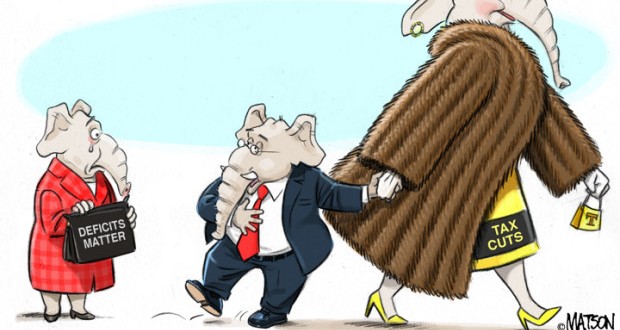By Ralph Martire
To stimulate the U.S. economy to “levels you haven’t seen in many years”— President Trump is proposing to cut federal income taxes, for most folks in general, but predominately for really affluent families and mega-corporations. His proposal is so skewed to the wealthy that over the next 10 years, more than half of his multi-trillion-dollar tax cut will go to the wealthiest one percent. Big business does well too, gaining an estimated $4.1 trillion tax cut during the next decade. And that’s not the only justification offered for the president’s full-on, supply-side, tax cut. According to Senate Majority Leader Mitch McConnell (R-KY), this tax cut will “create so much economic growth, it [will] begin to pay down the nation’s debt.” Which sounds too good to be true—because it is.
By now, every American who is objective or can-do math should know that the proposed supply-side tax cuts won’t work as promised. Why expect certain failure? First and foremost is something called “history.” Supply-side tax cuts have never worked as promised. Never. Second, focusing tax cuts on affluent individuals and corporations is not an effective way to stimulate private sector job growth—which pretty much explains why history has proven supply-side economic theory is bogus.
Start with history first. Top federal income tax rates for individuals were very high from the end of World War II through 1980—ranging from 90 to 72 percent. During that sequence, the U.S. economy grew at an average rate of 3.8 percent per year, in real, inflation-adjusted terms. Meanwhile income distribution slightly favored the top, with the wealthiest 10 percent realizing roughly 34 percent of all growth in income over that period, leaving 66 percent of income growth for the bottom 90 percent in earnings to share. Still, these were pretty good times, that included a strong middle class and real income growth for all earners.
Then came supply-side under President Reagan, who cut the top marginal income tax rate from north of 70 percent to 38.5 percent in 1981. President George W. Bush then cut the top rate down to 35 percent in 2001, while also cutting capital gains and dividend tax rates, which all primarily benefited the most affluent. That’s nearly four decades of supply-side. And the results ain’t pretty. In fact, average U.S. economic growth from the Reagan Administration through the end of George W. Bush’s second term was 2.8 percent annually after inflation. That’s one full percentage point lower than during the previous, high-tax era, and translates to about $150 billion less in annual economic activity. There was never any trickle-down effect. Meanwhile, income inequality became much worse, with more than all real growth in income going to the wealthiest 10 percent. Everyone else earned less after inflation in 2007 than in 1980. And because the promised economic growth never materialized, federal deficits exploded.
Which should surprise no one, because tax cuts mostly benefiting businesses and affluent families can’t be expected to stimulate job growth. Here’s why: the economy is primarily, as in around 68 percent, consumer spending. Tax cuts for affluent folks won’t generate much new consumer spending—because individuals at the top of the ladder already have rapidly growing real incomes. In economic terms, they have a low “marginal propensity to consume,” that is, they are unlikely to spend any tax relief they get. No bump in consumer spending, no job growth.
Business tax cuts also don’t incentivize job creation, because businesses only hire more workers when they actually need additional capacity to satisfy growing demand for whatever they sell. It makes no sense for a business to utilize tax relief to hire folks if there’s no work for them to do. Excess capacity is wasteful, and cuts profits.
Which means there’s literally no reason to believe President Trump’s proposed tax cuts will stimulate the economy, and every reason to believe they’ll grow the national deficit.
Ralph Martire is executive director of the Center for Tax and Budget Accountability, a bipartisan fiscal policy think tank.
 Westside Story Newspaper – Online The News of The Empire – Sharing the Quest for Excellence
Westside Story Newspaper – Online The News of The Empire – Sharing the Quest for Excellence




